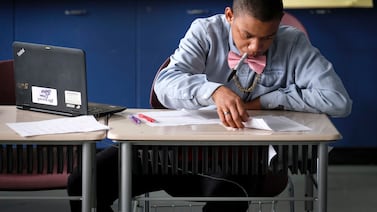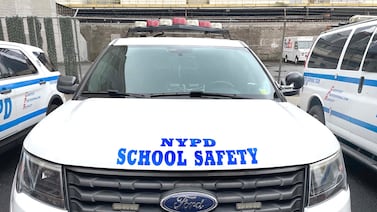A program aimed at bolstering the numbers of Black and Latino students in New York City’s prestigious specialized high schools continues to enroll a majority of Asian American students, according to recently released data.
The Discovery program is for eighth graders from low-income families who score just below the cutoff for the Specialized High School Admissions Test, or SHSAT. If they successfully complete coursework during the three- to five-week summer program, it could be their ticket into Stuyvesant, Bronx Science, or one of the other six specialized high schools that require the test as the sole admissions criteria.
For September’s rising ninth graders, after 4,050 test takers received an offer based on their test scores, the city extended offers to 855 students to participate this summer in the Discovery program. (Not everyone who gets invited into the program will accept the offer or end up enrolling at a specialized high school.) Nearly 60%, or 509, of the participants in this year’s Discovery program were Asian American, according to city data. That’s even higher than the share of Asian Americans who got offers to specialized high schools based on the SHSAT, which was about 53%.
Overall, Asian American students make up about 17% of students citywide.
Meanwhile, nearly 12% of the Discovery program seats — or 99 — went to Black students, and 20%, or 172, went to Latino students. That’s higher than the overall percentage of Black and Latino students who got specialized high school offers based on the test, 3% and 6%, respectively.
It’s still not representative of the school system as a whole: Roughly 24% of the city’s students are Black across the city, and 41% are Latino.
The numbers of Black and Latino students admitted to specialized high schools based on the entrance exam remains stubbornly low. This year, Stuyvesant, for instance, accepted just seven Black students based on SHSAT scores. That was a higher number than three other specialized high schools, including Staten Island Tech, which accepted zero Black students based on the test.
Tweaking Discovery program to boost numbers of Black and Latino students
A few years back, as city officials saw that the program helped more white and Asian American students gain admission to eight city high schools, they tweaked the program. In 2020, Mayor Bill de Blasio expanded the program to 20% of seats at specialized high schools, up from 13% the year before. De Blasio also changed eligibility requirements so that students must come from schools where most of their peers are economically disadvantaged.
The share of Black and Latino students in the program, however, is slightly lower than the first year after the program’s expansion. In 2020, nearly 35% of the offers in the Discovery program went to Black and Latino students, which was about 3 percentage points higher than this year’s offers.
That year saw 50% of the offers go to Asian American students, nearly 10 percentage points lower than this year’s offers.
The percent of white students, however, has dropped nearly in half from 14% in 2020 to about 7% this year.
The composition of students in the Discovery program will reflect that of the total SHSAT test-taking pool, education department officials said, since taking the SHSAT is still required for entry into the program.
But there’s still a mismatch between the number of Black and Latino students who took the test and qualified for spots in the Discovery program, according to city data. Of the roughly 27,700 eighth graders who took the SHSAT this school year, nearly 21% were Black and 26% were Latino.
The SHSAT, enshrined by state law in 1971, has long been controversial, with integration advocates blaming it for the low number of Black and Latino students at specialized high schools. That same state law also created the Discovery program for high-performing students from “disadvantaged” families to gain entry to the coveted high schools. But over the years, the program fell by the wayside at some schools, and was not operated consistently. In 2016, for instance, just 120 students received offers to five specialized high schools through the Discovery program. Stuyvesant and Bronx Science had long before stopped participating at that point.
Specialized high schools continue to be a battleground
Many Asian American families have pushed back against efforts to change the admissions process for specialized high schools, and a group of Asian American parents, along with Asian civil rights groups and a parent-teacher association, filed a lawsuit in 2018 against the Discovery program. They claimed that Asian American students would be squeezed out of the specialized high schools and said the program violated their civil rights. A federal judge in September dismissed the case, citing that more Asian American students had been offered seats under the program.
Nyah Berg, of the integration advocacy nonprofit New York Appleseed, was unsurprised that Discovery hadn’t done much to shift the demographics of specialized high school students given that it simply expanded the same system of basing admissions on a single test.
“The Discovery program does what it can, but at the end of the day, it’s a bandaid on a much much larger systemic wound,” she said in an email.
She also said that challenges remain in making Black and Latino students feel welcome at specialized high schools.
For some, it has not been easy to feel a part of the school culture, and that could affect who applies. Students may find themselves “battling systemic racism and microaggressions” at specialized high schools, Berg said.
“It’s not just the admissions process but also what happens once accepted and you are in the school,” Berg said.
There’s not only more work to desegregate the schools, she said, but also to integrate them.
Amy Zimmer is the bureau chief for Chalkbeat New York. Contact Amy at azimmer@chalkbeat.org.





